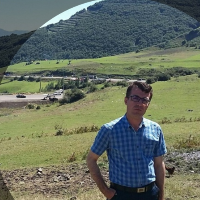Determining the Important stations and Physicochemical Parameters of Surface water Quality Measurement in Gorgan-Rud Basin (Iran) Using Multivariate Statistical Techniques
Author(s):
Article Type:
Research/Original Article (دارای رتبه معتبر)
Abstract:
This study focuses on evaluating the effectiveness of surface water quality monitoring network and identify monitoring stations and water quality parameters, which are important in assessing annual variations of water quality in Gorgan-Rud Basin, Golestan Province. Cluster analysis (CA) was used to sort cases (monitoring points) into groups. Principal component analysis (PCA) and factor analysis (FA) techniques were applied for these objectives. In this study water quality data of nineteen water quality monitoring stations over a 23-year time period (1996-2018), were analysed. Principal component analysis has determined a reduced number of three principal components that explain over 95.47 % of the data set variance. Results indicated that three monitoring stations (Taghi-Abad, Shir-Abad, and Nodeh) were identified as less important in explaining the annual variance of the water quality parameters. Based on the coefficient of determination improvements of regression relations, concluded that removing of the less important stations (from 19 to 16) can help the cost effectiveness and meaningful data collection of the monitoring network in the study domain. In addition, results revealed more important water quality parameters. Results shows that total hardness and EC are most important parameters at first component and in the second component, pH and HCO3 are appropriate for assessing variations of water quality in the Gorgan-Rud Basin. The clustering procedure highlighted two different groups in which the sampling sites have similar characteristics.
Keywords:
Language:
Persian
Published:
Irrigation & Water Engineering, Volume:13 Issue: 49, 2022
Pages:
421 to 439
https://magiran.com/p2489414
مقالات دیگری از این نویسنده (گان)
-
Spatial assessment and zoning of landslide risk in Zamkan watershed using support vector machine and logistic regression
Fariba Esfandyari Darabad, Ghobad Rostami, *, Mousa Abedini
Hydrogeomorphology, Autumn 2024 -
Land degradation intensity mapping using environmental factors and Sentinel-2 derived spectral indices in an arid region in south of Iran
Mohamamd Ebrahim Afifi, *
Anthropogenic Pollution Journal, Winter and Spring 2024 -
Determining the spatial correlation and pattern of changes in the height and volume of runoff in the sub-watersheds of Sharganj Birjand region
Reza Chamani, *, Mahin Kalehhouei,
quantitative geomorphological researches, -
Spatiotemporal Variations of the Rainfall Erosivity with Considering Snow Cover Correction Coefficient in the Iranian Part of the Caspian Sea Basin
, Abdulvahed Khaledi Darvishan *,
Whatershed Management Research,


